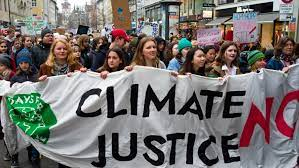‘The chasm between the climate action being taken and the emissions cuts required is set out bluntly in the new “global stocktake” report from the UN, produced in collaboration with member nations. As it stands, nations will belch out about 22 billion tonnes more carbon dioxide in 2030 than the climate can cope with if the global temperature rise is to be held to 1.5°C and the worst impacts of the climate crisis are to be avoided. The 22 billion tonnes that must be eliminated is equivalent to the combined emissions of the top five polluters today: China, the USA, India, Russia and Japan. Furthermore, the systemic transformation of every aspect of society that the report says is required needs to start kicking in quickly enough to halt the relentless rise of emissions seen since the Industrial Revolution within just two years.’ – An excerpt from a recently released Guardian published article ‘Chasm between climate action and scientific reality laid bare in UN stocktake’
Already at 1.1°C, it is essential to keep global average annual temperature rise to below 1.5°C, a recent Financial Times (FT) published article ‘World way off track to meet Paris climate goals, says UN report’, highlighting the United Nation’s stocktaking report on climate change, indicated that ‘The world is way off track to tackle climate change and remains headed for a temperature rise of up to 2.6°C and must take urgent action…’
There is indeed a serious lack of commitment, or progress towards achieving climate goals, as the same article pointed out ‘The UN report on progress by countries that pledged to cut their greenhouse gas emissions under the 2015 Paris Agreement found that there remained a vast gap between actions planned and what needed to be done. Despite almost 200 countries promising to set out plans for net zero emissions, many setting targets by 2050, the report said the world was “not on track”.’
Hence, given the fast-closing window of keeping the global temperature rise to below the desired threshold of 1.5°C, therefore, requires a much better commitment from countries, and in turn, makes the upcoming COP28 meeting in Dubai in the later part of 2023, that much more significant.
Here, while the component of ‘climate finance’ remains critical for making the green transition to much-needed more resilient, and environmentally responsible economies, especially for developing countries, and in particular highly climate vulnerable countries like Pakistan– which, for instance, went through catastrophic flooding last year, causing both loss to life, and billions of US dollars in damages– the ‘loss and damage fund’ is moving at a very slow pace.
Given the climate change crisis is an existential threat to life on earth, and is also strongly linked to the Pandemicene phenomenon, it is indeed important, among other steps, to quickly phase-out fossil fuel subsidies, and also to substantially increase climate finance.
This was quite evident, given it was reportedly in November last year that this fund had been announced, but the timeline of its operationalization had already made it clear that it would move slowly. A November 20, 2022 Al Jazeera-published article ‘Historic ‘loss and damage’ fund adopted at COP27 climate summit’ pointed out in this regard ‘Countries at the United Nations COP27 climate summit in Egypt have adopted a final agreement that establishes a fund to help poor nations cope with the extreme weather events caused by global warming. …However, many of the more contentious issues regarding the fund were pushed into talks to be held next year, when a “transitional committee” will make recommendations for countries to then adopt at the COP28 climate summit in November 2023. The recommendations will cover “identifying and expanding sources of funding”, which refers to the vexed question of which countries should pay into the new “loss and damage” fund.’
Hence, as anticipated, there is a lack of financial commitment to this fund, as an August 28 Al Jazeera–published article ‘Are climate reparations finally on the way for vulnerable countries?’ pointed out in this regard ‘Funds required for loss and damage are expected to reach $671bn annually by 2030, according to calculations by the Loss and Damage Collaboration. Current funding stands at less than $500m annually. …The V20, a coalition of the 55 most climate-vulnerable countries, has estimated its members already spend more than 20 percent of their combined GDP on loss and damage because of climate change.’
Having said that, while there is a lack of funding in terms of climate finance, fossil fuel subsidies stand at a high level, as highlighted by an August 24 FT-published article ‘Global fossil fuel subsidies and costs hit record $7tn in 2022, IMF reports’ as follows: ‘Global fossil fuel subsidies hit a record total of $7tn in 2022 as governments rushed to shield consumers from soaring energy prices sparked by Russia’s invasion of Ukraine, the IMF estimates. The IMF study said subsidies for coal, oil and natural gas in 2022 were equivalent to 7.1 percent of global gross domestic product. This represented more than governments spent on education, and two-thirds of what was spent on healthcare.’
Given the climate change crisis is an existential threat to life on earth, and is also strongly linked to the Pandemicene phenomenon, it is indeed important, among other steps, to quickly phase-out fossil fuel subsidies, and also to substantially increase climate finance.
A recent Guardian-published article ‘A critical moment’: UN warns world will miss climate targets unless fossil fuels phased out’ pointed out in this regard ‘Governments are failing to cut greenhouse gas emissions fast enough to meet the goals of the Paris agreement and to stave off climate disaster, a major report by the UN has found. Meeting the goals will require “phasing out all unabated fossil fuels”, the report says, in an acknowledgment that some oil-producing countries may find hard to take.’























